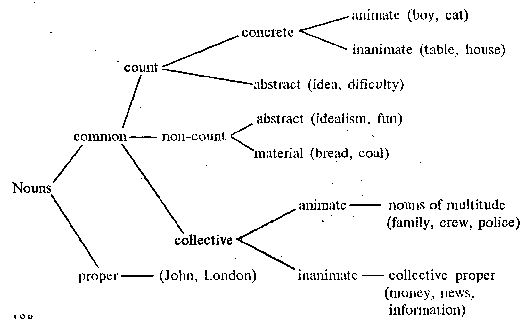
133
Concrete nouns semantically fall into three subclasses.
1. Nouns denoting living beings - persons and animals:
boy, girl, dog, cat.
2. Nouns denoting inanimate objects:
table, chair.
3. Collective (собирательные) nouns denoting a group of persons:
family, crowd.
There are some nouns which may be classified both as count and non-count. They often have considerable
difference in meaning in the two classes.
Count nouns
Non-count nouns
He used to read an evening paper.
She was a beauty.
They hoped to have pleasant experiences.
I saw him in a group of youths.
They wrappped up the present in brown paper.
Beauty is to be admired.
He has a great deal of experience.
Vie was speaking with the enthusiasm of youth.
A noun of material used as a count noun undergoes a semantic change so as to denote: kind of, type of: He
found her drinking Chinese tea, which she didn't like — but what could one do, other teas were common. The
same can be seen in the title A. Conan Doyle devised for a story "Upon the Distinction Between the Ashes of
the Various Tobaccos".
Morphological composition
§ 169. According to their morphological composition nouns can be divided into simple, derived, and
compound.
Simple nouns consist of only one root-morpheme: dog, chair, room, roof, leaf.
Derived nouns (derivatives) are composed of one root-morpheme and one or more derivational morphemes
(prefixes or suffixes).
The main noun-forming suffixes are those forming abstract nouns and those forming concrete, personal
nouns.
Abstract nouns
Concrete nouns
-age: leakage, vicarage
-(i)an: physician, Parisian, republican

